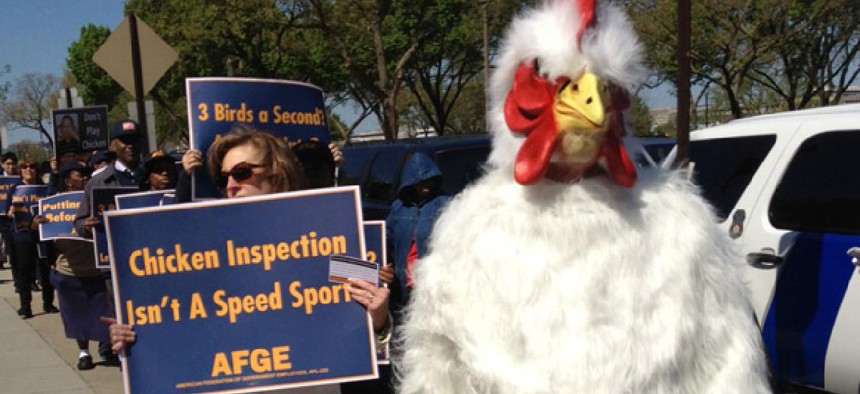USDA ‘playing chicken with safety,’ protesters charge
Poultry inspectors balk at Agriculture’s proposed changes.
Poultry inspectors, union representatives and a few men in chicken costumes on Monday protested the U.S. Agriculture Department’s proposed changes to the poultry inspection process.
USDA wants to expand a pilot program that replaces some federal poultry inspectors with inspectors employed by the processing plants themselves.
The program has been in place at 20 chicken and five turkey slaughterhouses in the Southwest and Southeastern United States since the late 1990s. USDA now wants to expand the program to include about 200 facilities.
The program hastens the chicken inspection process. Currently, inspectors from the department’s Food Safety Inspection Service examine about 35 birds per minute. Under the pilot program, inspectors examine 175 birds per minute, USDA said.
But the 35 birds per minute statistic does not accurately reflect the reality of the inspection process, USDA officials said. Birds move down an inspection line at a speed of 140 birds per minute, with two inspectors on each side of the line on hand to examine them. An increase to 175 birds per minute is not the four-fold increase in examination speed protesters claimed, said Ali Almanza, a Food Safety Inspection Service administrator.
The program’s expansion also could result in the loss of up to 1,000 federal inspector jobs.
But protesters outside USDA headquarters on Monday, including labor union members and watchdog groups, chose to protest the change for consumer safety reasons, holding signs that read “Speed Kills,” “Chicken Inspection Isn’t a Speed Sport” and “Don’t Play Chicken With Safety” to express concerns about the pilot program.
Under the change, a federal inspector remains part of the process, but only at the end of the line. Opponents of the pilot claim that those inspectors are permitted to take only 80 carcasses from hundreds of thousands off the line per shift. But USDA says an inspector can stop the line at any time and claim that routine sampling by FSIS inspectors at the end of the line, and that the pilot actually increases the number of carcasses required in “routine sampling” procedures.
Typically, federal inspectors have received about three years of training to examine the insides of chickens for fecal matter, disease or other forms of contamination that can lead to food-borne illnesses. Some fear private inspectors would not receive adequate training.
Tony Corbo, legislative representative for the consumer rights group Food and Water Watch, said the new process rushes critical controls.
“Whether you’re trained or not, you’re not going to be able to catch stuff,” Carbo told Government Executive.
USDA has argued the change would be good for both consumers and taxpayers. According to congressional testimony given in March by Undersecretary for Food Safety Elisabeth Hagen, the project would save taxpayers more than $90 million during its first three years of expansion and could lower production costs by $256 million annually.
Streamlining the inspection process could help prevent food-borne illness by addressing contamination before carcasses are placed into chillers, Agriculture has argued. The change could prevent more than 5,000 food-borne illnesses a year, the department estimated.
USDA said earlier this year in the Federal Register that the current poultry inspection system is outdated, arguing it was developed when “visually detectable animal disease were more prevalent and considered to be more of a concern than they are today.”
Allowing private poultry inspectors to check and discard carcasses earlier in the slaughter and production process could allow plants greater flexibility to develop their own procedures for condemning contaminated carcasses, the proposal claimed.
The nonprofit Government Accountability Project said it is slated to release a report this week concluding that although private inspectors would be examining carcasses earlier in the processes, the speed of the new process makes it difficult to look inside the bird, where leftover fecal matter and other contaminants often are found, said Felicia Nestor, an attorney who worked with the watchdog group to investigate the pilot program.
Phillys Mckelvey, a retired USDA poultry inspector who worked on the first pilot project in Guntersville, Ala., said she believes companies involved in the pilot did their best. The plant in Guntersville required specific training for its inspectors, but she is concerned training may not be kept up if the pilot becomes policy.
“If this goes nationwide, it’s going to be a total nightmare,” she told Government Executive at Monday’s protest.
When Mckelvey began her career 44 years ago as an inspector’s helper, inspectors “looked inside every bird, inside and outside, from every side,” she said. “All they do on the pilot is they sit and watch the birds go flying by.”
This story has been updated.



